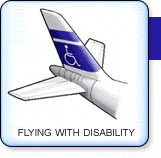|
|
Flying With Disability
| On board Medical Assistance |
|
On board medical assistance will always be available during a flight, though the expertise of this assistance will depend on the carrier and type of journey.
The majority of International flights have a set procedure for dealing with medical incidents on board, and a cabin crew are trained accordingly. Larger, long-haul flights will tend to carry first-aid kits, and a medical kit to be used only by a medical doctor or other qualified persons to treat in-flight emergencies.
Some airlines are now also equipped with medical diagnostic devices for transmitting clinical signs via the on-board telephone system to a medical expert on the ground. An automated external defibrillator, for cardiac emergencies, are increasingly available on international flights, to be used by qualified staff.
Airlines can legally reserve the right to refuse travellers who are unable to look after their own needs for the duration of the flight, so it is essential to ensure that you travel with a competent escort to assist you.
Travellers confined to wheelchairs should be aware that this also, unfortunately, may include the transfer from your wheelchair to seat/toilet and vice versa.
We strongly recommend that you contact the airline in advance for guidance. For a complete contact page of all major airlines click here.
As a general rule, airlines will demand that an attendant responsible for the traveller is on hand, if you are travelling on a stretcher or in an incubator.
If the individual suffers from a mobility impairment to the extent that it impedes his or her ability to evacuate the aircraft, then the carrier may also request that he or she flies with an assistant.
Similarly, if the traveller suffers from severe hearing and vision impairments which might hinder his or her ability to respond to cabin-staff instructions in an emergency; or, likewise, due to a mental disability is unable to coherently respond to emergency instructions, then an assistant may be required.
If the airline will not provide an attendant, then the accompanying attendant will have to pay for the flight of accompanying attendant's carriage. It is always a good idea to discuss your situation with the airline in advance, as they can be conducive to providing free carriage for attendants on quiet flights.
Another option is to look for a volunteer already booked on the same flight. Remember the attendant in the majority of cases is merely a requisite to cover any situations arising in the event of an emergency. An off duty-employee may also be available to assist.
Always check ahead to see whether you are required to fly with an attendant. Keeping an open dialogue with the airline is essential. In a worst case scenario, you may only learn after booking your flight that you must fly with an attendant, whereupon there are no seats remaining on that particular flight.
|
|
|
